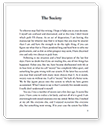Aileen Wuornos Essays and Research Papers
Instructions for Aileen Wuornos College Essay Examples
Title: Aileen Wuornos and a general theory of crime
Total Pages: 5 Words: 1661 Sources: 3 Citation Style: APA Document Type: Essay
Title: You made a good start draft female serial killers You discussed interesting typologies motives You presented a case study Aileen Wuornos I deducted points reasons 1 4 You present case laws statutes related topic definition murder
Total Pages: 2 Words: 580 References: 20 Citation Style: MLA Document Type: Research Paper


